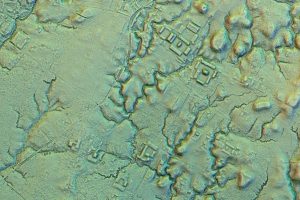
The remains of a previously lost civilization have been uncovered in the dense rainforests of Ecuador, consisting of extensive earthworks, irrigation canals, roads and cities that may have been populated by hundreds of thousands of people. What’s more, this civilization appears to have existed between 3,000 and 1,500 years ago, possibly making it the oldest known civilization in Mesoamerica.
“This is older than any other site we know in the Amazon,” remarked the research team’s leader, Professor Stephen Rostain, the director of investigation at France’s National Centre for Scientific Research. “We have a Eurocentric view of civilization, but this shows we have to change our idea about what is culture and civilization.”
Much like the extensive megalopolis of Maya infrastructure uncovered in Guatemala in 2018 that forced archaeologists to revise our culture’s view of how extensive Maya civilization was, this discovery was made using aircraft-borne LiDAR (Light Detection and Ranging) scans to peer under the canopy of the dense rainforests that have hidden the ruins for nearly a millennium and a half. Having started their survey in 2015, the researchers uncovered over 6,000 raised earthen platforms within a 300-square kilometer (116 square mile) area in the Upano valley, nestled in the foothills of Ecuador’s Andes.
Many of the platforms measure 20 meters long by 10 meters wide (66 by 33 feet), and rise between 2 and 3 meters (6.5 and 10 feet) above the forest floor. Arranged in groups of three to six and clustered around a central plaza, the platforms appear to be the foundations of homes, although the researchers believe that some of them may have been used for ceremonial purposes; one complex included a much larger platform, measuring 140 meters by 40 meters (459 by 131 feet), covering an area slightly larger than a football field.
The platforms are surrounded by fields that would have been used to grow crops—maize, beans, manioc and sweet potatoes, according to an analysis of the culture’s pottery—with a series of small canals excavated around them for drainage. The low density of the five main settlements discovered led Rostain to describe them as “garden cities.”
“The valley was almost completely modified,” Rostain remarked.
These settlements are connected by a network of roads that cut straight across the landscape between the communities, with the longest stretching for 25 kilometers (15.5 miles), although it may continue past the area that was surveyed. These roadways are peculiar in that their builders went to a great deal of effort to ensure that they were straight, even going as far as digging down five meters (16.4 feet) into the soil at some points, instead of having the road simply go around higher hills. This characteristic led the research team to believe that the straightness of these thoroughfares may have had some significance in their builder’s culture.
Unlike other Amazonian settlements that were abandoned after the arrival of Europeans, the cities at Upano appear to have been abandoned sometime before 500 CE, more than a millennium before Christopher Columbus landed in North America. Although the reason for the Upano culture’s dispersal is a mystery, layers of volcanic ash were found during excavations at the sites, suggesting that a nearby eruption forced the inhabitants to leave the valley.
Such an extensive Mesoamerican culture extending this deep into antiquity “changes the way we see Amazonian cultures,” according to study co-author Antoine Dorison. “Most people picture small groups, probably naked, living in huts and clearing land—this shows ancient people lived in complicated urban societies.”
“This shows an unprecedented degree of complexity and density of settlement for this early time frame,” remarked Michael Heckenberger at the University of Florida. “The authors justifiably conclude that the complexity and scale are comparable with better known cases, such as the Maya, at this time.”
Subscribers, to watch the subscriber version of the video, first log in then click on Dreamland Subscriber-Only Video Podcast link.
This account reminds me of some reports I saw in recent years that early Martian communities who escaped the destruction of the Martian atmosphere millions of years ago traveled to Earth … some of them, it was said, established secret colonies in parts of the Amazon in order to hide from the early Earth civilization which damaged Mars.